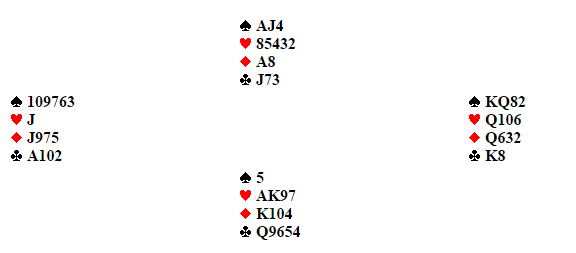Fuente: kwbridge.com ![]()
![]()
![]()
![]()
One trait that all expert bridge players have in common is the ability — and the energy — to “count out” every hand they play. Counting involves using all the available clues from the bidding and play to count the high-card points in the unseen hands and count the number of cards each player holds in each suit.
Some of it is guesswork, but if you put some effort into it and draw the correct inferences, you can often come up with an extremely accurate picture of where all the cards are. And the more you practice, the easier it gets.
This hand is an interesting example of the benefits that come from paying attention and drawing the correct inferences. My partner, Tom Kniest of St. Louis, used all the evidence available to get an accurate count on the hand and bring home a difficult game contract.
EW vulnerable


Opening Lead: Six of Spades.
| Tom (South) thought his 4-card suit was strong enough for a 1-level overcall, so he bid 1 |
Tom backed up his judgment with careful declarer play to make his thin game. He won the spade opening lead in dummy and ruffed a spade in his hand, then led a diamond to dummy’s ace for another spade ruff. When he now cashed the AK of trumps, he had all the information he needed about the opponents’ distribution.
East had shown up with 3 hearts and presumably 4 spades (if spades had been 6-3, West would surely have bid his spades again over the 3![]() bid). It also appeared that East had at least 4 diamonds, because if he had held 3-3 in the minors, he would have opened 1
bid). It also appeared that East had at least 4 diamonds, because if he had held 3-3 in the minors, he would have opened 1![]() .
.
That left East with 1 or 2 cards in the critical club suit, but which ones? Tom had also been counting the high-card points, and he was virtually certain East had a singleton or doubleton club honor for two reasons:
(1) Without the club ace or king, East would have at best a poor 10-count, not enough for an opening bid; and,
(2) If West had held AKx(x) of clubs, he would probably have led one of the honors on opening lead.
With that picture of the layout, Tom led the Club Queen from his hand, guaranteeing only two club losers if East held Ax, Kx or a singleton honor in the suit. West won the club ace and led a diamond to Tom’s king. Tom now played East for the doubleton honor by leading a low club and ducking in dummy, which collected the now-singleton king. East could cash his trump queen, but dummy was up and Tom scored his +420.
Bidding Tip
An overcall usually promises a 5-card suit, but competing with a 4-card suit can be good strategy when you have the right type of hand. Consider making an overcall with a 4-card suit if you have:
- A strong suit — usually three of the top five honors (KQ104, AQJ7, AJ107), or two of the top three honors with good “body” (high spot cards in suits like AK98, KQ97, AQ87).
- A ruffing value — an outside singleton or doubleton.
- Good outside strength — quick tricks and well-placed honors.
- A hand pattern not suitable for a takeout double — shortness in an unbid suit, for example.
- Room to bid your suit at the 1-level (2-level overcalls on 4-card suits are reserved for those with death wishes).
Esta entrada también está disponible en: Spanish

